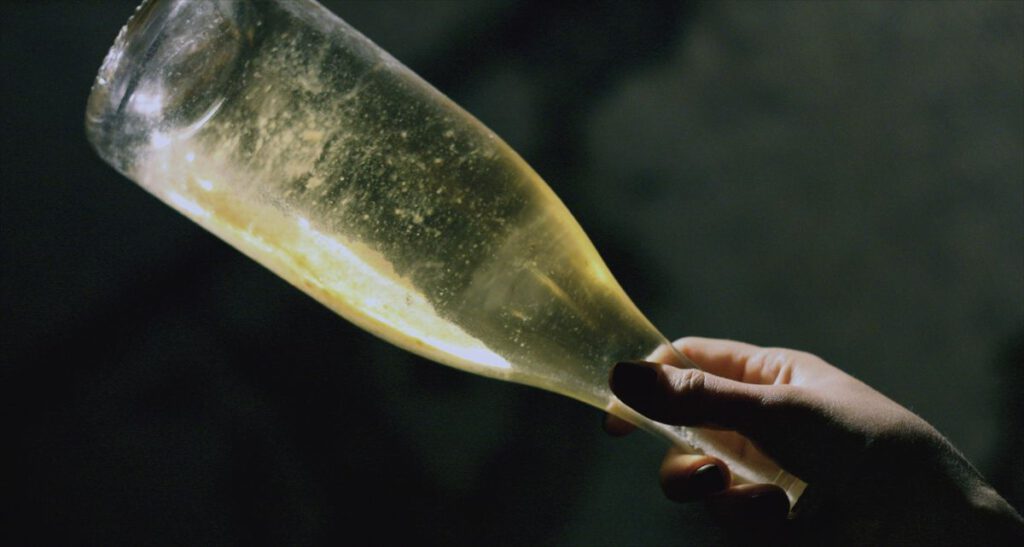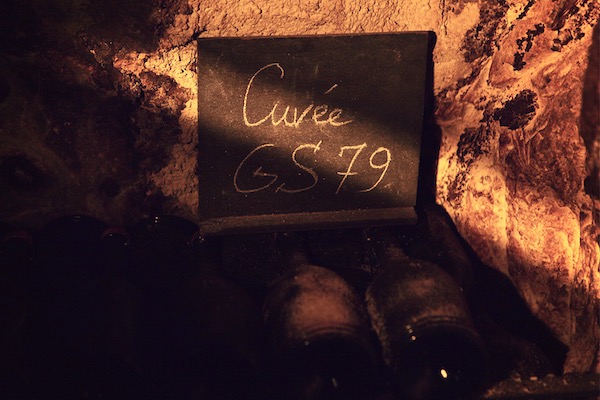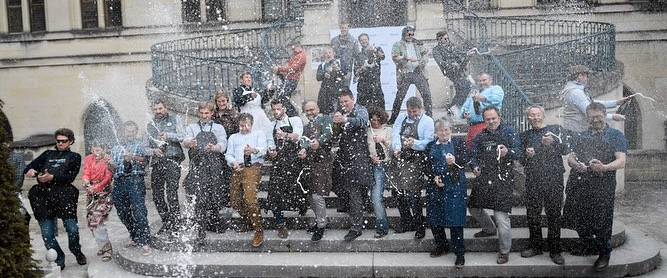A little background
Today, the best champagne comes from houses dedicated to quality in the vineyard and winery. As they become better known, they are receiving the recognition they deserve. More importantly, these delicious champagnes are making their way into our glasses.
The days of relying on a few big houses with massive marketing budgets turning out generic fizz are over. But champagne is more than just fizz. It’s wine, and should be consumed like any other.
For optimal enjoyment I encourage you to trade in your flutes and coupes for a universal white wine glass and serve a little warmer than fridge cold. And, believe it or not, good champagne tastes just as good when the bubbles have gone flat. This is when you can best appreciate its vinous quality. (To really bring out these flavours, pair a glass with some salty hard cheese – Percorino or Reggiano Parmigiano work a treat.)
Trade in your flutes for a proper fizz glass
‘In success you deserve it and in defeat, you need it.’
Sir Winston Churchill
Winston Churchill was a famous Champagne lover. As a fizz enthusiast myself, I completely agree with Winston’s sentiment: champagne is a drink for all occasions.
Champagne is produced in a wonderful variety of styles, which is part of what makes it such a fun category to explore… and drink! But it’s more than just a celebratory welcome drink, champagne in its various styles can be enjoyed at every stage of a celebration and meal. From a crisp aperitif style to rich Blanc de Noirs, complex blends, and, when done right, some of the most inspiring Rosé.
Understanding what distinguishes one style from another is important to identify your personal preferences.
The diversity present across the category can make it difficult to generalise, but three major considerations that will influence the way champagne tastes include grape variety, region and the cuvée.
In addition to these factors there is a myriad of potential stylistic choices available to a producer, including pre-tirage élévage, time on lees and dosage; the influence of different viticultural and winemaking approaches should not be underestimated. But, the impact of choices made in the vineyard and the cellar is so immense, I think they deserve articles of their owns.
Below we dip our toes into the sea of champagne styles, beginning with a brief overview of the three key varieties, where they are found and how they typically appear in champagne.
Champagne Varieties
The three major varieties in Champagne: Pinot Noir, Chardonnay and Meunier. On rare and special occasions you’ll find champagnes made with all seven permitted varieties, which include Fromenteau (aka Pinot Gris), Abanne, Pinot Blanc, and, Petit Meslier. There is increasing interest in these varieties, resulting in more experimental cuvées, more delicious champagnes and greater opportunities to innovate in a historically tradition-bound region.
Nevertheless, the majority of champagnes comprise a blend of the three key grapes. Each variety brings its own character, structure and potential style to the wine. Appreciating how these features are expressed is most obvious in varietal expressions, such as Blanc de Blanc and Blanc de Noir, but can be evident across all cuvée styles.
Click to enlarge
Meunier (Pinot Meunier)
When visiting Champagne in 2019, one winemaker referred to Meunier as “le vilain petit canard” – the ugly duckling. While Pinot Noir has the elegance, Meunier is an awkward cousin – a little rough around the edges, all acidity and upfront fruit. However, as with cygnet in Hans Christian Anderson’s fairy tale, in the right context our perceptions of the variety are transformed and its underlying elegance shines through.
Meunier (no longer called Pinot Meunier in Champagne) is an important component in blends, providing youthful exuberance to champagnes with soft, mid palate fruitiness, moderate acidity but without considerable structure. Given its fruity generosity, Meunier-dominated wines tend to drink well when young.
The variety planted throughout the various sub-regions of Champagne and is a popular choice for growers in cooler north-facing vineyards, in the damp, frost-prone Vallée de la Marne, and in the cold valleys of the Aisne.
Varietal Meunier champagnes are rare, but a handful of winemakers are working with the grape to give it the attention it deserves. A great example of this is R.Pouillon ‘Les Chataignieres’ Extra Brut. We caught up with Fabrice Pouillon and learned about his unique winemaking. Read about it here.
Explore the full range of 100% Meunier fizz here.
Pinot Noir
If Meunier is a swan, the Pinot Noir is hardly a duck. In champagne Pinot Noir offers structure, power and body, with mid palate concentration, refreshing acidity and focused fruit.
Unlike Meunier, it has great ageing potential with long-lasting fruit character that can also develop as the wine matures. As in Burgundy, Pinot Noir lends itself well to site-specific or terroir driven expressions. In addition to its capacity to produce complex autolytic characters, Pinot Noir flavours tend to be red fruited with some darker fruit in Blanc de Noir examples.
Pinot Noir is planted throughout Champagne, but the regional big guns are in the north around the Montagne de Reims and Vallée de la Marne.
Chardonnay
Chardonnay supplies a laser-like, linear acid structure, a lithe body and an overall finesse. It is less broad shouldered than Pinot Noir and may appear more delicate and nervy. In a blend it the perfect complement to Pinot Noir’s richness and Meunier’s fruitiness; as a varietal wine, it yields elegant, sophisticated wines with great ageing potential.
Chardonnay is traditionally grown on the east-facing slopes of the Côte des Blancs but has also proved successful in many other sub-regions, especially the Côte de Sézanne.

The Basic Styles
Champagne in a variety of styles. At its core, good champagne possesses a filigree acidity, a delicate but expressive fruit character and an overall cool climate sense of balance, precision and purity.
Winemakers in Champagne are master blenders. They have an arsenal of options at their disposal, whether combining varieties, fruit from different sites and sub-regions, fermenting and maturing base wines in different vessels, or using reserve wines from a solera system assembled over a period of decades.
Equally some of the finest champagnes are made from single vineyards and vintages.
Like many of the worlds large wine regions there are efforts underway to further define the sub-regions of Champagne, partly in a push to recognise the quality of sites previously afforded less recognition.
Below is an outline of the basic styles and cuvées; the full fleet of champagne styles on offer will be explored future posts.
The Cuvée

The cuvée refers to the general blend of a champagne. This can be a blend of varieties, a blend of vintages (non-vintage or close vintage), a blend of sites or villages, or even a combination of the three. Explore our blended champagnes here.
The traditional champagne mantra is that blending is all important, however we are starting to see increased promotion of single village and lieux dits wines as well as more varietal champagnes, such as Blanc de Noirs and Blanc de Blancs.
Blanc de Noirs
French for ‘white of blacks’ this cuvée describes a white wine made from dark-skinned grapes – Pinot Noir or Meunier – by pressing them very gently and running the pale juice off the skins as early as possible. Blanc de Noirs are a particular speciality of the Aube as Pinot Noir and Meunier dominate plantings. However, many of the best examples can be found in the Montagne de Reims and Ay in the Vallée de la Marne.
How do you get white wine from red grapes? A cross section of dark-skinned berries reveals the fruit’s clear flesh. With quick pressing and limited contact with skins, the juice will be virtually uncoloured.
Based in Bouzy, André Clouet is a Blanc de Noirs specialist; the Grande Reserve Brut NV is 100% Pinot Noir and is seriously good. Want to go one better? It’s also available as a Magnum.
From Ambonnay, Benoît Maruget is producing awesome Pinot Noir wines, such as ‘Le Grand Ruelle’ Blanc de Noir Grand Cru.
Also from this part of Champagne, Egly Ouriet produces a varietal Pinot Noir in addition to a Meunier Blanc de Noir. From the village of Ambonnay, Egly-Ouriet’s Grand Cru Blanc de Noirs Vielles Vigne will take you to a happy place.
Discover the full range of Blanc de Noirs here.
Blanc de Blancs
French for ‘white of whites’, this term indicates a champagne made exclusively from Chardonnay grapes. Celebrated examples come from the Côte des Blancs, a mostly eastern-facing slope that owes its name to the colour of the grape that is planted: 95% Chardonnay. Notable villages include Avize, Cramant, Le Mesnil-sur-Oger, Oger, Chouilly and Vertus.
A great starting place for this style is Pierre Péters Blanc de Blanc Cuvée de Réserve Grand Cru NV, a blend of multiple Grand Cru sites and vintages from the Côte des Blancs.
Another favourite, fast assuming the role of a modern classic, is the Agrapart Terroirs Blanc de Blancs NV is a stunning example of Blanc de Blanc style. To really get to the heart of this style, compare it with the same wine, but with +3 years in bottle. Drink side by side to see how bottle age affects the character of quality champagne.
Check out our selection of Blanc de Blancs here.
Rosé
While not necessarily a varietal style, Rosé is another important cuvée style amongst champagne and can be something of a litmus test for the quality of a winemaker/grower.
Rosé champagne can be produced in two different ways: by maceration, where destemmed black grapes are left to soak until the desire colour is achieved (typically 24 to 72 hours), or by blending, where base red and white wines are blended prior to tirage – the latter is the most commonly used method.
The addition of red wine, typically from Pinot Noir, contributes more than just colour; it also emphasises red-fruited flavours and breadth and texture on the palate.
For truly sensational experience of Rosé champagne, the Benoît Marguet Amobonnay Rosé Grand Cru Brut Zero and the R.Pouillon Rosé Brut NV are two particular standouts from the category.
Explore our Rosé champagne offering here.
To really understand the different styles of champagne and, more importantly, your personal preference I encourage to taste widely and with curiosity. Discover our excellent selection of champagnes here. You can also dive deeper into the world of Champagne further in the Wine Bites Mag.


















You must be logged in to post a comment.